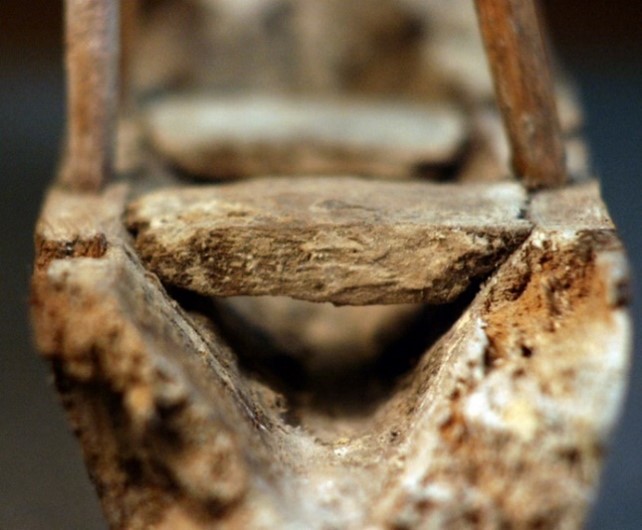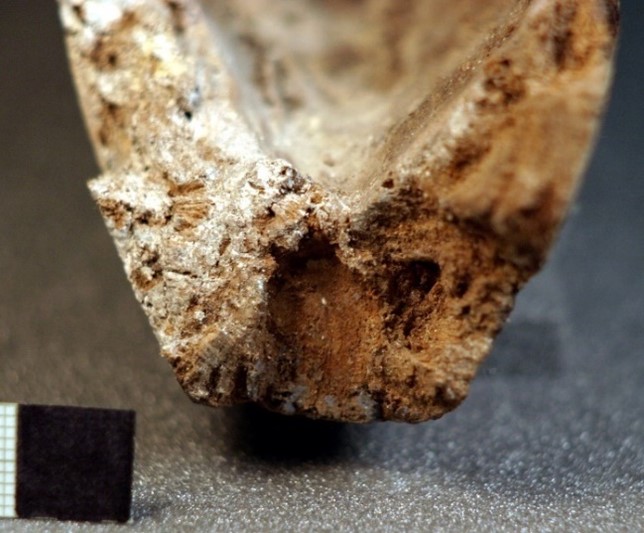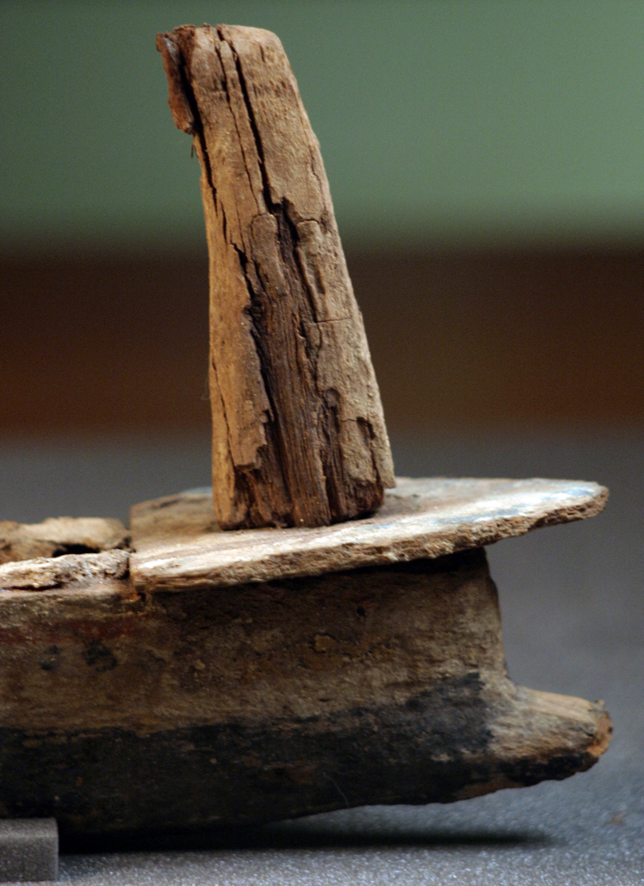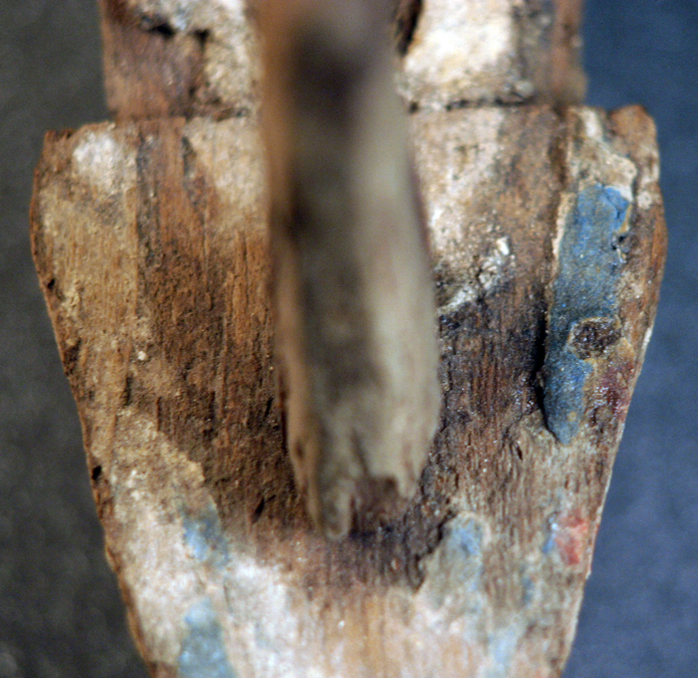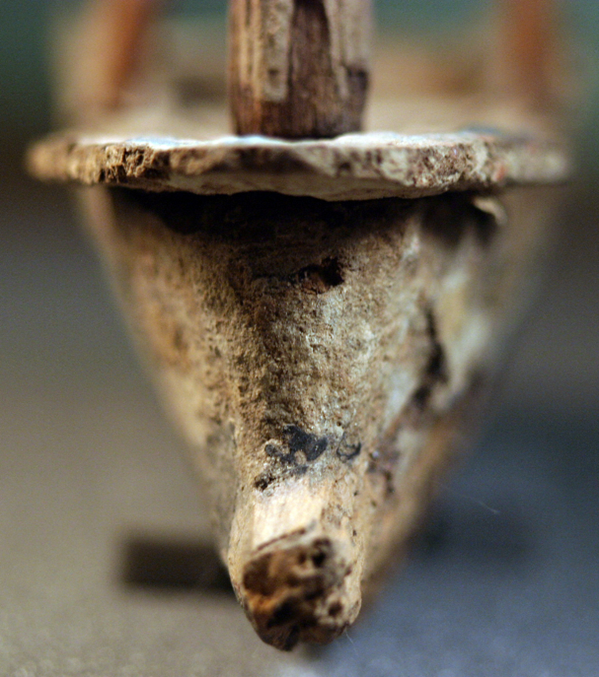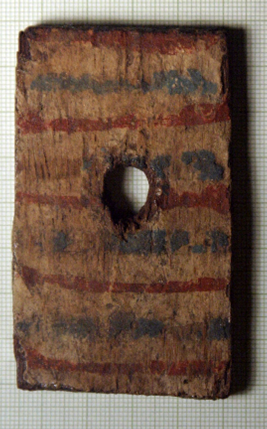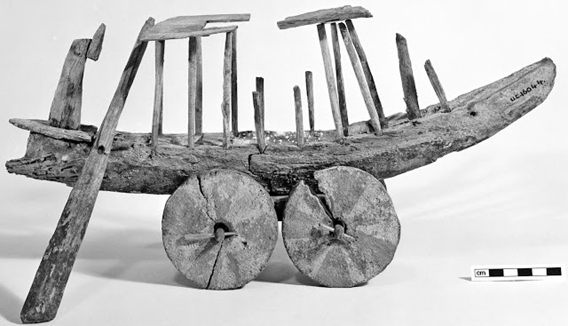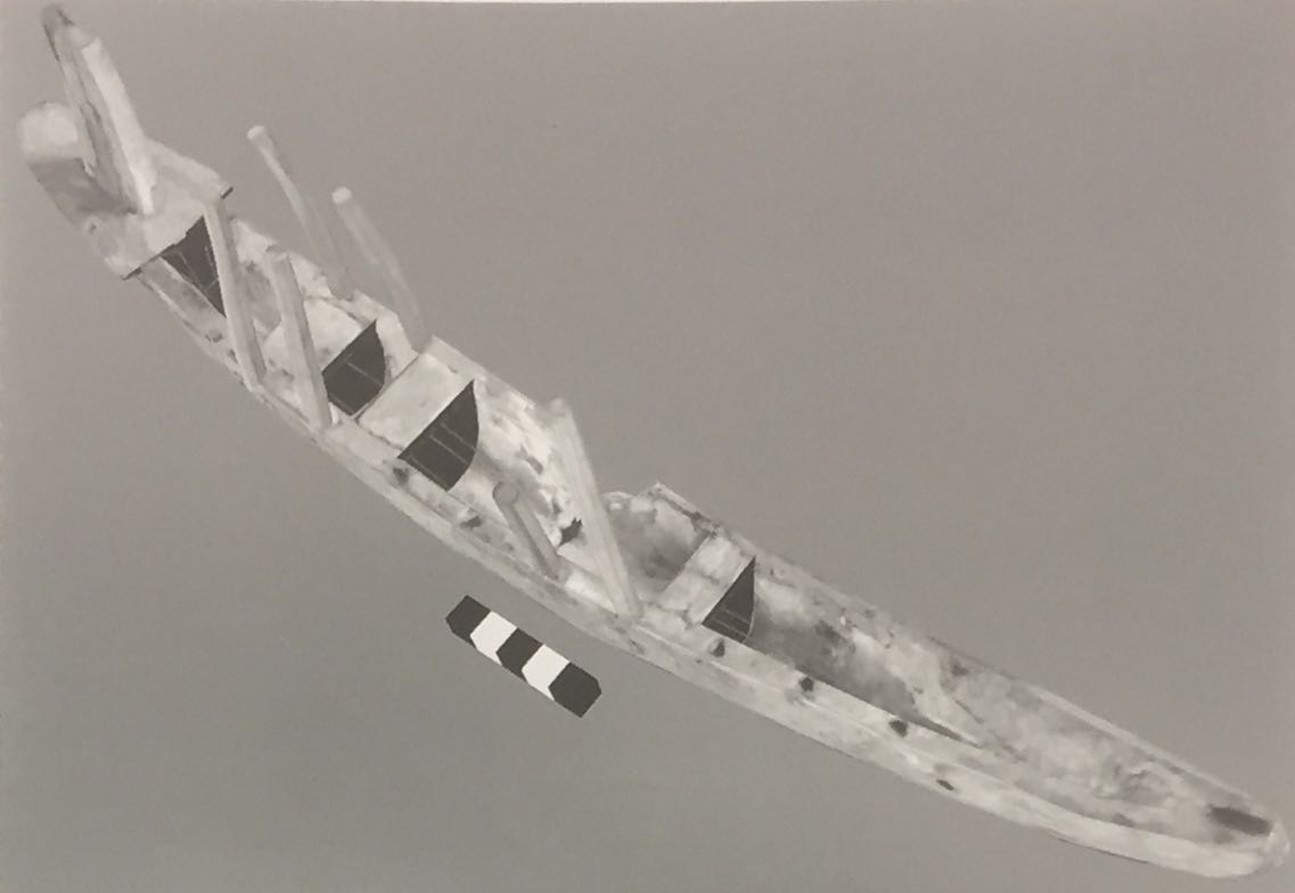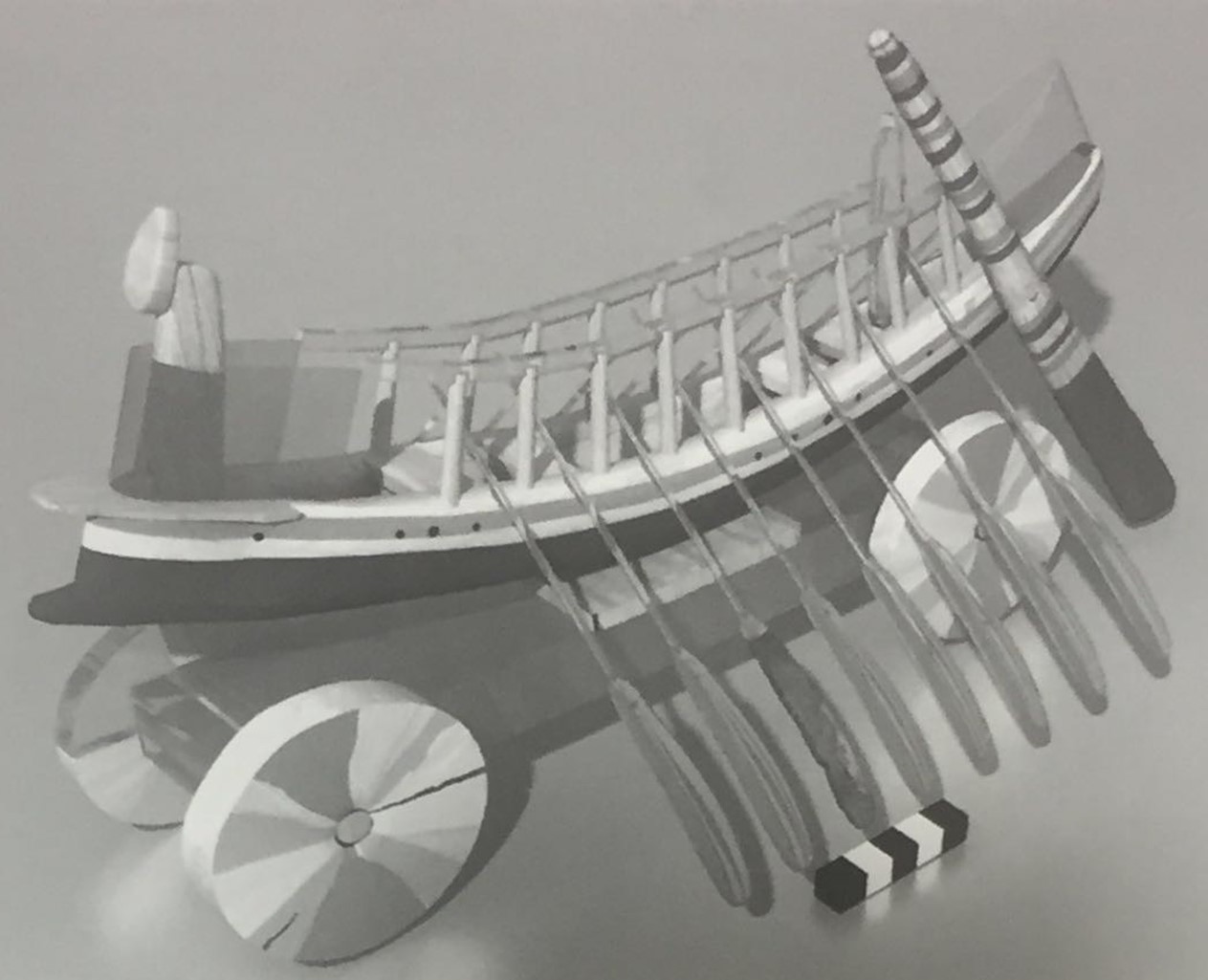A Helladic-style oared galley (likely a pentekonter) featuring a curved hull, stanchions, oarports, and a stempost decorated with an upturned bird's head. The beam to length ratio is 1:7. The hull is slender and rockered, its base flattened amidships to allow for the model to sit upright on a flat surface. There is a robust waterline projection that extends 1.5 cm beyond the lower extremity of the bow. The extremity of the bow projection currently aligns with the forward edge of the forecastle deck but its end has been abraded and therefore it may have been longer originally. The stempost is prominent and nearly vertical, with a slight inward slant. It does not continue the line of the stem but rather rises oddly in the center of the forecastle. It is obvious that the model-maker sacrificed accuracy for the sake of convenience since the stempost serves to lock the model's forecastle in place. The stempost originally had an amygdaloidal-shaped vertical continuation at its upper extremity which is visible in Petrie's drawing and the museum's photographs. There is a flat and roughly triangular forecastle deck that extends over the model's bow. It is 2-3 cm thick and extends by 1.3 cm over the hull at the bow, by 6 mm to starboard, and by 5 mm to port. Its upper perimeter has remnants of light blue paint. Inboard of this there is a dark, horseshoe-shaped stain that indicates the location of a forecastle screen that is now missing. This stain continues onto the caprail to starboard, hinting that the screen may have continued this far. The port side provides the clearest indication, where the blue paint shows a clear edge where the screen piece had sided to it. The same border is observable on the starboard side but to a lesser degree. At least part of the screen was therefore painted blue. On the underside of the model at the break amidships there is a hole (1 cm diameter and 1.3 cm deep) that served to receive a peg that would have attached the hull to its support structure. The hole's lower edge shows remnants of blue paint. The model is hollowed to indicate a planked vessel. The caprail averages 8 mm, with the interior of the hull carved out to a depth of 2 cm below the caprails. The hull groove begins immediately aft of the forecastle deck and continues to 7 cm from the stern. The upper surface of the hull is covered with a layer of white to yellow gesso. The stern is best preserved on the port side. The gesso covering the stern is absent in a clear clear pattern along the upper edges of the caprail and in the center of this area in the shape of an elongated oval. Together these two areas of missing gesso strongly indicate that some form of sterncastle and screen existed there. It must have been made of a similar slip of wood as that of the forecastle, glued to the center of the hull and resting on the caprails. There is a hole for attaching the quarter rudder on the port quarter, located 6.5 cm from stern and 5mm below the caprail. Astern of it is a blue line in an L-shaped turned 90 degrees clockwise. Just below the caprail forward of the hole is a small patch of blue paint. The model originally had nine pairs of stanchion holes on either side. The first pair is set back 5.5 cm measured from the aft end of the stem platform to the center's holes. The average distance between holes is 2.7 cm. The bow section of the model has 3 holes on either side. The first two of these on either side currently have long pegs solidly glued into them. The third hole on the starboard side was destroyed by the midship break. The port side of stern section is 22.5 cm long and has 6 stanchion holes. There are three broad thwarts, their upper surface covered in gesso. They were wedged into place inside the hull. There is no evidence of a hole for a mast step, but gesso is missing amidships along the inner side of the hull which indicates a now missing thwart or mast-step partner piece that was already in place when the hull's interior was given a coating of gesso. The model has polychromatic decoration, best preserved on the starboard side of the bow section. The bottom of the hull is painted black. The pigment used was asphalt, which was used for waterproofing ships. The use of this material on the hull is therefore likely more than just an artistic choice. Above the black paint, at about half of the distance between its upper edge and the caprail, runs a sloppy line of irregularly spaced black dots painted over a light wash of gesso. These dots begin at stern edge of the forecastle deck. In Petrie's reconstruction however they begin almost at the stem. These are no longer visible. The dots were applied haphazardly and are not equidistant. There were 25 dots per side and Wachsmann interprets them as oarports, suggesting that the model depicts a 50 oared galley (pentekonter). Above the line of dots at a height of 3.5 cm from the bottom of the hull and just below the caprail runs a continuous, faded horizontal line of red paint (4 mm wide) which continues under the forecastle deck but disappears beneath the edge of the stempost. It is possible that it originally continued around the stem.
The model has 30 detached pieces. There are no human or animal figures associated with it. There are a total of 18 stanchion holes. Of the eight short pegs mentioned only five survive. The quarter rudder consists of a single piece of wood, the loom and blade merging gently. Its exterior side is decorated with alternating black and red stripes, while the lower 9 cm are painted black to match the appearance of the hull. The top of the loom has a groove. There is no evidence of a tiller. The quarter rudder was on the port quarter, attached by a now-missing peg through holes at the center of the rudder and on the model. The model also has a piece described as a pavois: a rectangular plaque decorated with parallel blue and red lines, with a hole pierced through its center. This element served as a base for Egyptian cult and funerary ships when these were transported overland. Petrie's reconstruction places it amidships below the hull. Its presence indicates that the model does not depict a ship but rather a cultic ship-cart on wheels.
There are four wheels decorated with radial wedges and in some cases squiggles of white, red, blue and brown on their external faces. They clearly form two sets. The larger wheels have a diameter of 8.1 cm, while the smaller 7.6-7.7 cm. The larger ones were probably placed at the stern to help the quarter rudder clear the base. The presence of the wheels presume a chassis or carriage.






